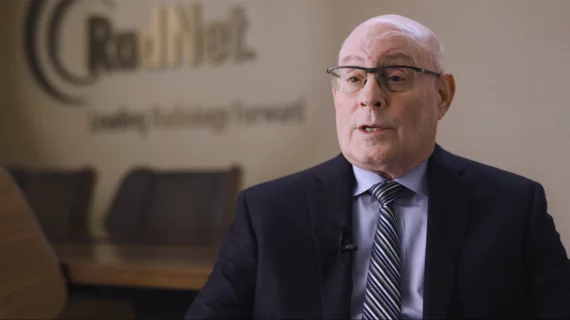RadNet is sitting on almost $700M in cash. CEO Howard Berger, MD, discusses how he plans to deploy it
Imaging industry giant RadNet Inc. is sitting on nearly $700 million in cash after several recent financial maneuvers. CEO Howard Berger, MD, recently discussed how his company plans to deploy these resources, with further expansion potentially on the horizon.
Berger discussed RadNet’s strategy during the Jefferies 2024 Global Healthcare Conference on Wednesday in New York City. The publicly traded, Los Angeles-based company was able to boost its balance sheet by raising $230 million in capital through a public stock offering in March. RadNet also recently refinanced over $1 billion in debts, allowing it to pay down balances and further fuel growth.
In Q1, the company recorded adjusted earnings of nearly $58 million, a 21% year-over-year uptick, with its debt-to-equity ratio a healthy 1x. Berger said the improved financial picture has placed RadNet in an advantageous position when holding conversations with potential partners.
“The benefit of having cash on your balance sheet is it has people look at RadNet differently, whether you're a shareholder or a debt holder,” Berger told attendees on June 5. “I think everybody is more comfortable that we're able to make the kind of strategic business decisions a little bit more aggressively than we might've in the past.”
RadNet also raised another $259 million through a previous public stock offering that closed in June 2023. It used $30 million of those funds to acquire seven imaging centers in Houston, marking the company’s first new market since 2020. Berger said RadNet wants to position itself where the company could investigate other new markets via larger acquisitions to “create a good platform.”
Currently, about 37% (or 137) of its imaging centers are operated through joint venture partnerships with large hospital systems. RadNet continues to explore other such opportunities, with RadNet either buying into a health system’s existing outpatient centers or working to grow the capacity of sites the imaging group already owns.
“We are all experiencing the same issues with demand and lack of capacity,” he noted. “Cash makes the conversations a little bit more fluid in terms of us creating the kind of opportunity that we think is necessary to do more of a scale operation,” Berger added later.
He sees limitless possibilities, with RadNet also considering investing further in artificial intelligence. The company has spent tens of millions to acquire multiple firms and is now attempting to monetize the technology by charging mammography customers extra to have their images processed by artificial intelligence.
“We've given ourselves the ability to almost go in any direction here, and we didn't accumulate the cash for the arbitrage, if you will,” Berger told attendees. “We're really going to be in a position, I think, to deploy it in ways to grow the company like we have been and also potentially take advantage of some of the digital health and AI opportunities that we believe are going to come our way. That industry itself has fallen a bit on difficult times, with increased interest rates and some of the pullback of venture capital funds in getting into startups or, let's say, AI's businesses that are not yet generating much at all in the way of revenue.”
RadNet handles about 45,000 procedures per day and has troves of data and opportunities to deploy AI. Its Enhanced Breast Cancer Detection program now charges $40 to have AI read images and has seen 32% year-over-year growth on the east coast where the service is most established. Berger sees opportunity to try something similar in prostate and lung cancer detection. RadNet also has held conversations with original equipment manufacturers about its AI products.
“What we're trying to do is put these tools onto the equipment itself and they may become a distributor for us, and we may become helpful in driving sales of their products,” Berger said. “So, the alignment of RadNet is unique simply because we own this technology and we have such a huge base to implement it and test it on, which is driving more and more of the conversation.”
RadNet bills itself as the “leading” national provider of freestanding, fixed-site diagnostic imaging services in the United States. It now has a network of 375 centers and counting, concentrated in eight states: California, Maryland, Delaware, New Jersey, New York, Florida, Texas and Arizona.
You can find an archived recording of the conversation here.

